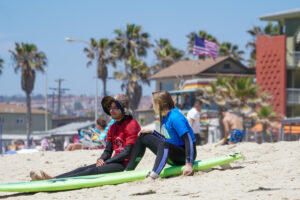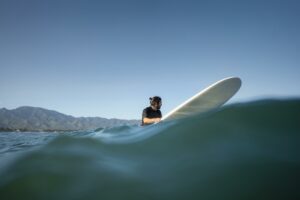Like any other activity, you must start somewhere and surfing is no different. In this sense, understanding more about surfing for beginners is a great way to learn how to surf. With that in mind, we prepared this content for you. Let’s talk about the main equipment, places to practice the sport and much more. Check it out!
What do you need to know and what equipment is needed?
There are some basic surfing terms that you need to know to get started. The “point break”, for example, have waves that are consistent and last longer. To put it simply, a point break is a point at which a wave breaks over a rock. When the conditions are ideal, the point break creates an exhilarating wave to ride. Point breaks can have rock, coral, or sandy bottoms. Places called “beach break” have sandy bottoms, which make them more fickle to receive waves. The “reef break”, on the other hand, are waves that break at shallow depths, but close to corals. Therefore, only advanced practitioners surf in places like this.
How to choose the ideal board
Surfing doesn’t require much to be practiced, only fair wave conditions and a board to start. However, there are several surfboard models that you can choose from. Larger boards, for example, give more stability and are more flexible, which are the best option for beginners.
Another point that requires attention is your weight, as the board must be able to support you. Consider the surfboard you will acquire according to your budget, but never buy a board just because it looks cool or because it is used by professionals, it will make your improvement harder.
Before you buy, ask for the help of a professional to understand which shapes and sizes are right for your specific needs, which will depend on the location and who is practicing the sport. You can test boards from friends or rent, so you’ll know which one you like and adapt best.
Although, for all beginners we always recommend Wavestorm Foam boards – they are 8-feet surfboards at an affordable price. Its size and material make it very floatable, which is what you want to begin.
You may also need clothes suitable for surfing, as they facilitate the practice of the sport and protect the body. There are several types of materials that are suitable for each type of situation, but for colder waters, there are neoprene wetsuits that act as thermal insulators for the practitioner.
What are the main precautions when surfing?
Every sport has rules and some conduct to follow, and surfing is no different. Before you buy your board and go into the ocean, check out the precautions you need to surf safely:
- learn about the beach and wave of the place before surfing;
- respect the beach warnings and instructions from the lifeguard;
- always use the leash on the board;
- respect the surfers and swimmers who are at sea;
- if a storm arises, get out of the water immediately;
- make regular maintenance of your board;
- know drowning prevention measures;
- learn to swim.
What other activities can help in the practice of surfing for beginners?
You can combine surfing learning with other sports. Thus, in addition to improving physical fitness, you will have more confidence to play in the waves. In California, for example, you will find the following activities:
- stand up paddling;
- kitesurf – board guided by a kite directed by the wind;
- wakeboarding;
- skateboarding;
- boat sailing.
Tips to evolve faster in the sport
There are other things that can help you evolve in surfing. Some activities can help you learn faster and have a better understanding of what this sport is.
Learn from those who know
Whether in a surf school or with professionals, it is a fact that if you observe and are taught by those who know, you can evolve faster. Furthermore, it is a matter of safety to learn how to surf properly. Never practice alone or take classes with those who know little about the sport!
Study about surf
Find out how the sport works completely: its rules, techniques, types of equipment, locations, practitioners, and competitions. Also understand how a wave works, what is the behavior of the sea, and how to act in certain situations. The more you know, the more your perception of the sport will increase, and the better your level will be.
Prepare yourself physically
As surfing requires some physical conditioning, prepare your body to avoid cramps and increase your breath. This will not only help you to surf well and for longer, but it will be useful in emergencies and to withstand bigger and more difficult waves as you progress in surfing.
Evolve with the sport
It can take years to get out of surfing for beginners and enter the advanced level, but the more you practice, the less time it will be. In addition to the body, your equipment must also accompany the process.
There are big or small boards and styles like longboarder or stand up, so change equipment as needed and your goals in the sport. If you intend to surf in different places than usual, see what is the best equipment for this situation. If possible, have several options as you become better.
With this information, you already know the basics of surfing for beginners. Now start studying the sport and, most importantly, how to learn to surf!




